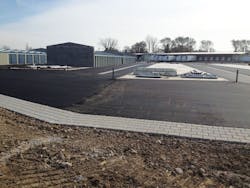Pavement: Green Development
Developers have been conditioned to compromise on projects in order to set aside room for storm water management facilities. The engineering community has become adept at squeezing in networks of pipe and ponds to comply with federal, state and local storm water regulations.
This mindset is costing developers millions of dollars for the purchase of land for storm water facilities (2 to 3 acres) and in lost revenue that could have been generated by selling and leasing more space or from having smaller production space. Municipalities may achieve storm water objectives by requiring developments to construct storm water ponds, but lose significant tax dollars on storm water facilities that have little value or are non-taxable.
Ferris Water Resources of Cedarburg, Wis., designed real estate company Sunset Investors’ new EZ Self Storage mini warehouses in Cudahy, Wis., in 2013. The design took advantage of green infrastructure to manage storm water within the development footprint. The design resulted in greater annual revenue, attracted grant funding to offset construction costs and reduced the annual storm water fee, and showed how a developer can increase the profitability of their investments by using green infrastructure to manage storm water runoff.
Regulatory Requirements
Regulatory requirements from a number of agencies placed heavy restrictions on development plans. for the site, which is adjacent to the Milwaukee General Mitchell International Airport. Development plans fall under Federal Aviation Administration (FAA) Advisory Circular 150/5200-33A, which places strong restrictions on the detention of storm water within 10,000 ft of an airport. The Milwaukee Metropolitan Sewerage District’s (MMSD) Chapter 13 required storm water discharged from the development to be restricted to 0.15 cu ft per second (cfs) per acre following a two-year storm event and 0.5 cfs per acre following a 100-year storm event. The Wisconsin Department of Natural Resources (DNR) required that new development achieve an 80% reduction in total suspended solids.
Design Challenges
The original design for the 303-unit self-storage facility proposed that runoff from the 7.2-acre property would be collected by a traditional storm sewer system and stored in a storm water detention pond at the back of the property. Getting approval for a storm water pond from the FAA would have been costly for the owner. Alternative treatment systems that would meet the DNR water quality requirements would have consumed more land and been costly to maintain. Storm sewers resulted in an overflow elevation of the pond that would be below the elevation of the city’s storm sewers.
In response to these design challenges, the Ferris team proposed subsurface gravel storage galleries that would run around the perimeter of the paved area and between the storage buildings. The permeable pavement was designed to capture and retain the water from all runoff events up to the 100-year design storm (4.4 in. of runoff). Runoff is captured with permeable articulating concrete block manufactured by PaveDrain. Independent testing estimated the permeability of the system to be around 4,000 in. per hour. This simplified the engineering and design of the system to just the determination of the volume of water to be captured.
Soil borings indicated that subsoils had sufficient infiltration capacity to drain the galleries within 24 to 36 hours. Modeling estimated that the gravel galleries would remove up to 50% of sediment carried in by storm water runoff and prior to infiltration. Therefore, with the pretreatment provided by the gravel galleries and their large footprint, the system was estimated to have a design life exceeding 20 years. With infiltration, the project avoided the additional expense of the design and construction of a complex multistage discharge structure and the costly connection to the city’s storm sewer in the street.
Sunset Investors noted that puddles and ice were a common safety and convenience complaint of self-storage facility customers. Ferris’ design corrected these problems by sloping the pavement from the doors of the storage units a short distance to a central shallow permeable pavement/gravel trench that conveys runoff to the main storage galleries located along the perimeter of the paved area.
Revenue Opportunities
The cost of the permeable pavement system was recovered within three to four years from various revenue sources.
First, the ability to build an additional 34 rental units was estimated to generate an additional $53,000 in annual revenue. Second, the project qualified for a $75,000 grant from the MMSD Green Infrastructure Partnership grant program. Finally, the development qualified for a $4,000 reduction in its annual storm water utility fee.
Green infrastructure has demonstrated that its benefits reach well beyond LEED certification and good environmental ethics. The Ferris team adapted green infrastructure practices to meet some of the most stringent performance criteria in the industry. Doing so allowed for more profitable developments, which contributed to the economic stability of the region.
There are a number of federal, state and local grant programs that developers can secure to offset a portion of green infrastructure construction costs. Developers and engineers who do not consider the use of green infrastructure to manage more of a site’s runoff potentially are missing the opportunity for greater financial rewards.
Download: Here


